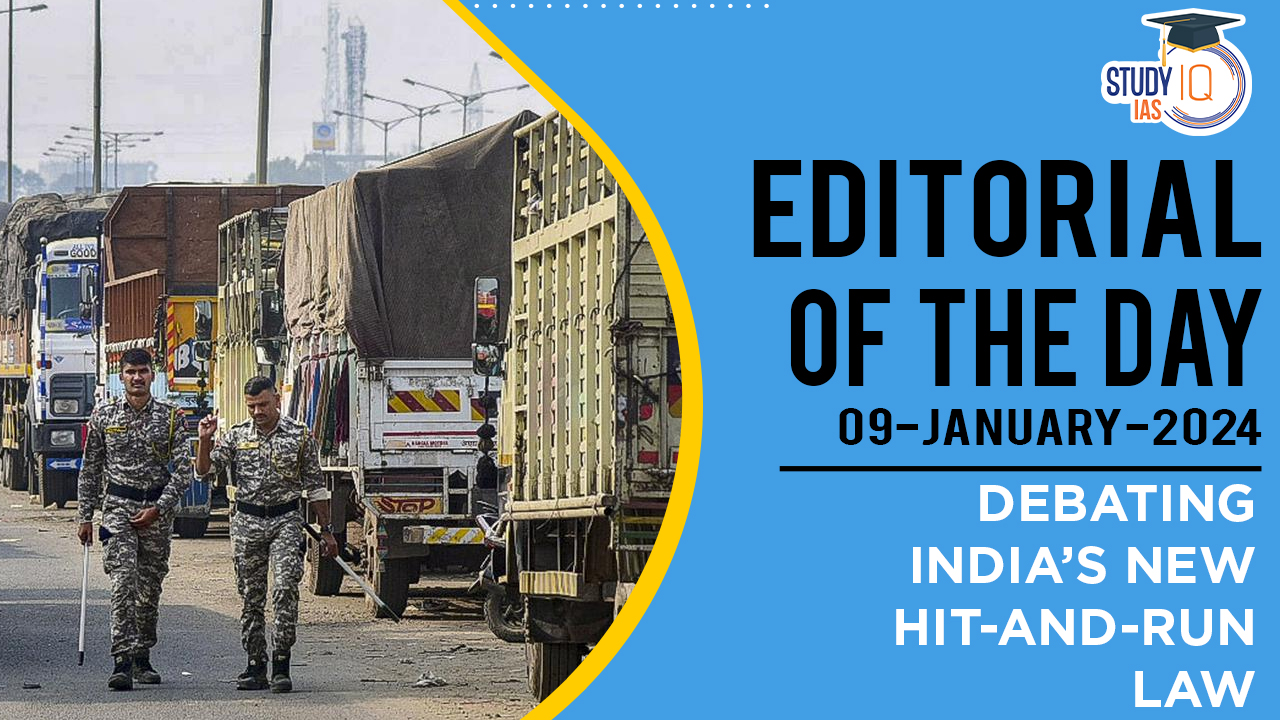Table of Contents
Context: Commercial drivers and transporters from different States are demonstrating against Section 106 (2) of the Bharatiya Nyaya Sanhita, 2023 (BNS), which enforces severe penalties for hit-and-run cases.
About Section 106 (2) of the Bharatiya Nyaya Sanhita, 2023 (BNS)
- Penalties for Hit-and-Run in Section 106(2): Specifies a maximum sentence of 10 years and an unspecified fine for hit-and-run cases, debunking rumours about a fixed Rs. 7 lakh fine.
- Non-Bailable Offence: Classified as a non-bailable section under the Bharatiya Nyaya Sanhita, 2023 (BNS).
- Reporting Requirement for Drivers:
- Drivers who flee to avoid immediate danger but report the incident soon after to the police or a magistrate will be charged under section 106(1) with a maximum penalty of 5 years.
- Failure to report the incident leads to charges under Section 106(2), carrying a harsher maximum punishment of 10 years.
- Comparison with Motor Vehicles (Amendment) Act, 2019: While Section 161 of the 2019 Act provides for compensation to hit-and-run victims, Section 106(2) of the BNS does not impose such a compensation obligation on the drivers.
We’re now on WhatsApp. Click to Join
Alarming Road Crash Statistics in India (2022)
- India recorded its highest road crash fatalities, surpassing 1.68 lakh deaths.
- On average, there were 462 deaths per day, approximately 19 per hour, or nearly one death every 3.5 minutes.
- Despite a global decline of 5% in road fatalities, India experienced a 12% increase in road accidents and a 9.4% rise in fatalities.
- More than half of these fatalities occurred on national and state highways, which constitute less than 5% of India’s total road network.
- India, with just 1% of global vehicles, contributes to around 10% of worldwide crash-related deaths, leading to an economic loss of 5-7% of its GDP annually due to road crashes.
Protestors Concerns And Demands
- Protest Against Harsh Penalties: Transporters are opposing the stringent penalty of 10 years imprisonment and a ₹7 lakh fine for drivers who leave accident scenes without reporting.
- Concerns Over Driver Challenges: The protesters highlight that the punishment doesn’t consider the difficulties faced by drivers, including long hours and challenging road conditions.
- Accidents Due to Uncontrollable Factors: They point out that some accidents are caused by factors beyond a driver’s control, like poor visibility in foggy conditions.
- Fear of Mob Violence: Concerns about mob attacks on drivers who stop to help at accident sites are fueling the protests.
- Perceived Unfair Blame on Drivers: Drivers believe they are often wrongly held responsible for accidents, and the law’s penalties are disproportionate and don’t reflect the realities of road transport.
- Potential Misuse by Law Enforcement: There is apprehension that the law might be exploited by law enforcement to the detriment of drivers.
Principles Underlying The Law
- High Rate of Hit-and-Run Fatalities: In 2022, 47,806 hit-and-run cases were reported by the National Crime Records Bureau, leading to 50,815 deaths.
- Law’s Dual Purpose: Penal laws aim to both deter reckless driving and penalise offenders who flee after causing a fatal accident.
- Mandate to Report Accidents: Offenders are legally required to report incidents to authorities, with failure to do so being criminalised.
- Enforcing Moral Responsibility: The law emphasises a moral obligation towards accident victims, translating this into a legal duty.
- Legal Precedent in Motor Vehicle Accidents: Under the Motor Vehicles Act, 1988, drivers must help injured persons, barring exceptional circumstances.
- The Delhi High Court’s ruling in Rajesh Tyagi vs. Jaibir Singh further underscores the importance of not fleeing accident scenes.
Are the Protests Against Section 106 (2) Justified?
- The belief that Section 106(2) of the BNS mandates a ₹7 lakh fine for not reporting an accident is incorrect; the Act doesn’t specify this amount.
- Section 161 of the 2019 Act provides compensation for hit-and-run victims but doesn’t hold drivers financially responsible.
- Section 106(1) penalises rash or negligent driving with up to five years’ imprisonment if reported, but Section 106(2) increases this to ten years if not reported.
- Despite increased penalties, the offence under Section 106(2) hasn’t been made non-bailable.
Recommendations for Improvement
- Reconciling BNS Clauses: The clauses in the BNS should be reviewed to prevent unfair treatment of over 35 lakh truck drivers in India.
- Equality in Punishment for Different Sectors: The exception for doctors under Section 106(1) suggests a need for fairer treatment across various sectors.
- Revisiting Section 106(2): There’s a need to distinguish between types of driving offences to avoid unjustly penalising drivers and to clarify liabilities.
- Applicability for Serious Incidents: Section 106(2) should apply mainly in cases resulting in death, not minor injuries.
- Alternative Measures for Lesser Offences: For minor injuries, alternatives like community service, licence revocation, or mandatory retests could be more appropriate than criminal penalties.


 RailOne App: Indian Railways Launches Al...
RailOne App: Indian Railways Launches Al...
 Special Intensive Revision (SIR) of Elec...
Special Intensive Revision (SIR) of Elec...
 Daily Quiz 01 July 2025
Daily Quiz 01 July 2025





















